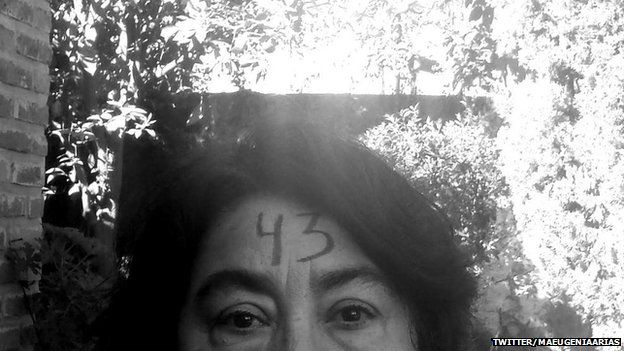Selfies for the missing in Mexico
- Published

In the latest twist in a protracted social media movement, thousands in Mexico have used Ash Wednesday to seek justice for the 43 students who went missing in September last year.
It's the case that has polarised Mexico: the disappearance and alleged mass murder of 43 male students from Ayotzinapa teacher training college in southern Mexico in September. Students from the college were on their way to protest over school hiring practices when they were stopped by police who shot at their buses. Three were killed and 43 others have not been heard from since. Mexico's attorney general Jesus Murillo Karam says the missing have been killed by a gang and their bodies burnt at a rubbish dump - an explanation rejected by families of these students and activists, who believe the military played a role in these events and have since taken up the students cause online and on the streets of Mexico.
Now the hashtag #43NoSonCeniza ("43 Are Not Ashes") has begun to pick up steam on Mexican social media. It aims to counter the government line about what happened to 43 male students. Activists are asking people to paint their forehead with the number '43', upload the pictures online and walk the streets to show their protest. The idea is to play on the traditional Ash Wednesday practice, where Christians mark the beginning of Lent by marking their foreheads with ashes, as a symbol of death and sorrow for sin.
The message of the activists has begun to gain traction online - the hashtag has been mentioned more than 6,000 times. "This Wednesday put a 43 on your forehead. Justice, truth and memory. #WearellAyotzinapa. Will you join us?," reads one tweet, while another says "because the 'historical truth' of the PGR [Office of the General Prosecutor] is full of inconsistencies."
Several on Facebook and Twitter have also changed their avatars to a black graphic with the hashtag and the date. Some users have also begun to post selfies with the number 43 etched on their forehead.
The campaign is the brainchild of a Mexico city-based artists' collective called ¿qué hacer? ("What to do"). They told BBC Trending they wanted to appropriate a Catholic ritual and turn it into a political expression. "We want people to remember, and keep remembering that the disappearance of the 43 students is still unresolved. To show our discomfort with the official version of facts, which tries to state that the students were incinerated and the military had nothing to do with it. Too many lies," a member of the group, who prefers not to be named, told us.
The campaign is picking up support but so far has not generated the mass national response that other social media trends related to the students' disappearance have. The hashtag #YaMeCanse, or "I am tired", has been used more than four million times since it first appeared in November.
Blog by Samiha Nettikkara
Next story: Turkish women share stories of abuse
You can follow BBC Trending on Twitter @BBCtrending.
All our stories are at bbc.com/trending
- Published29 October 2014
- Published9 December 2014